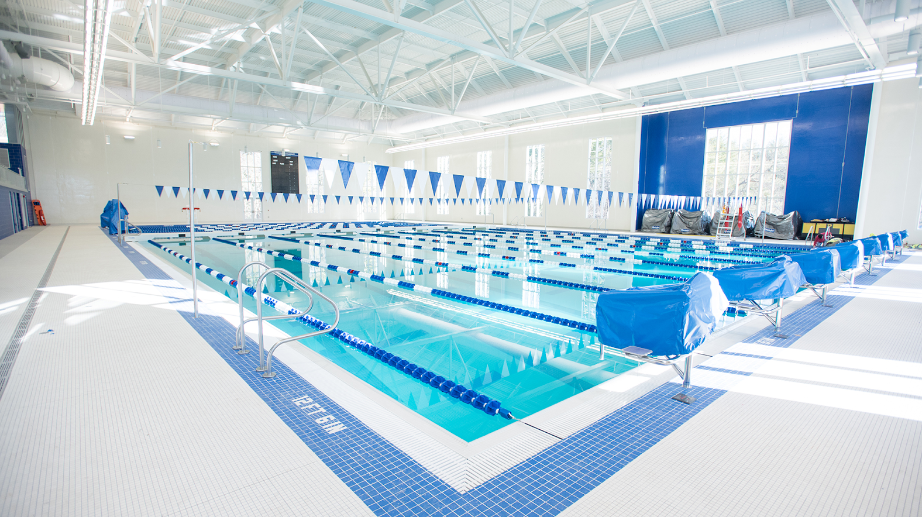Sink or Swim?
Sink or Swim?
In abandoning the swim test, the university no longer acts “in loco parentis.”
(W&L’s natatorium. Source: Washington and Lee University)
Washington and Lee University has dropped its mandatory swim test for students beginning with the class of 2027.
But the university’s much ballyhooed $22.4 million natatorium opened just in 2017. Among other features, it offers “wet classrooms.” Do you hear the loud clanging of cognitive dissonance yet?
The university offers state-of-the-art aquatic facilities without ensuring that each student is equipped to use them — much less able to draw on a needed life skill beyond their time at W&L.
* * *
My own years at W&L taught me all too well the importance of strong swimming skills. During my junior year, I foolishly tempted fate in the Maury River at flood stage. This was on day three of rising flood waters. The water was brown, surging over rocks the size of automobiles. Several other students were in our group. We had tubed the prior two days as the water rose, so we judged it safe enough to go again.
As soon as we sat in our inner tubes and launched, the current overwhelmed us. Two hundred yards downstream in mere seconds — coming up fast was a huge cross-river hydraulic that would have trapped us underwater.
Another student and I were first to abandon our tubes, and a frantic swim across the foaming cross-current began. Shore was 20 feet away. We both flailed across, the powerful current bashing us into rocks. I grabbed an overhanging branch. The other guy grabbed my foot to hang on, then clawed up my body and got a better branch; I crawled up on him to the bigger branch. We barely reached the rocks, coughing up water, bruised and dazed.
We searched for the others, climbing up the stone retaining wall to the road to get a better view of the river. On the road we saw a buddy, the best swimmer in our group, lying motionless on a rock nearly across the river, blue-gray in the face. He had been a champion swimmer in high school.
A third student down river 100 yards on our side, swam across and helped the nearly drowned student jump into the water and across a six-foot-wide rushing torrent. They crawled along the rocks upstream all the way back to cross over a small bridge spanning the Calfpasture River.
We all nearly died that day. Yes, we were ALL stupid. At least swimming skills saved us from our own stupidity.
* * *
The same idyllic environs which enticed my friends on that nearly fateful day continue to attract students. The Maury River is so close, so inviting. Students have enjoyed its cooling pools and rapids for decades. As they graduate and set course upon the seas of adult life, they will go to the beach, the lake, the river, travel across oceans, sail, and ride kayaks, canoes, ski boats, and ferries.
As aviators, engineers and product liability attorneys know, enough repetitions will often reveal a “remote” risk to be an eventual accident. The same holds true for daily life. Take a wrong turn and end up in a river; get caught in a rip tide at the beach; take a cruise and the ship founders in a storm; capsize a canoe while river fishing.
Parents must trust the school to teach our youth not only intellectual skills, but life’s physical necessities so that they can engage in the unexpected.
When parents send their children to W&L, “in loco parentis” is not just a dead Latin maxim, it is a legal obligation W&L carries — to help students gain life skills. That is what good parents do. But if they are not able, the school should teach students needed skills while they are in a learning environment.
Regardless of a student’s political stripe, swim skills should be part of their required college lesson portfolio, along with any required academic course.
Each W&L graduate should be equipped with swimming skills to not only survive, but possibly to act decisively in helping others survive. Such physical skills undoubtedly give a student confidence to better engage the world on its physical and intellectual terms.
The Board of Trustees rules the roost. Their primary duty is owed to the students’ welfare and proper instruction. The university is more than a private nonstock corporation with an over $2 billion endowment and shiny new buildings.
Once on campus, they are the school’s charges for intellectual development and safety. Remember why the university is here. Make sure each student physically able to do so learns to swim.
Sure, we all started off uncertain and uncomfortable. But that goes for academic exploration as well. Teaching courage and confidence is part of the university’s mission to prepare students as capable adults in a positive society, to give them confidence to survive common risks and uncertainties of life.
Besides, the swim test is far more valuable to students than drowning them in DEI race-baiting indoctrination.
[The opinions expressed in this magazine are the author's own and do not reflect the official policy or position of The Spectator, or any students or other contributors associated with the magazine. It is the intention of The Spectator to promote student thought and civil discourse, and it is our hope to maintain that civility in all discussions.]


